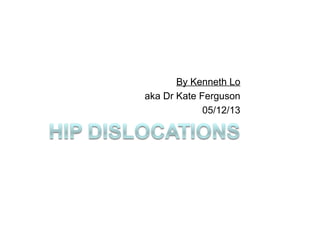
Hip Dislocation Management
- 1. By Kenneth Lo aka Dr Kate Ferguson 05/12/13
- 2. • Hip is a modified ball and socket joint. • Femoral head is deep in the acetabular socket – enhanced by the cartilaginous labrum. • Supported by fibrous joint capsule, ischiofemoral ligament, muscles of upper thigh and gluteal region. • Large amount of force needed to dislocated the joint – hence concurrent injuries
- 4. • Simple vs complex • Complex associated with fractures. • 3 main patterns in relation to acetabulum:- posterior, anterior, central.
- 5. Posterior dislocation • Mostly posterior dislocation (80-90% of dislocations in MVA) • Force via a flexed hip – knee striking the dashboard and transmits force through femur and hip.
- 6. • Posterior: - flexed, internally rotated, and adducted.
- 7. Anterior Dislocation • Femoral head situated anterior to acetabulum • Hyperextension force against an abducted leg that levers head out of acetabulum. • Also force against posterior femoral head or neck can produce dislocation
- 8. • Anterior: The hip is minimally flexed, externally rotated and markedly abducted
- 9. Central dislocation • ALWAYS fracture dislocation • Lateral force against an adducted femur – side impact MVA.
- 10. Neurovascular examination • Signs of sciatic nerve injury include the following: – Loss of sensation in posterior leg and foot – Loss of dorsiflexion (peroneal branch) or plantar flexion (tibial branch) – Loss of deep tendon reflexes at the ankle S1,2 • Signs of femoral nerve injury include the following: – Loss of sensation over the thigh – Weakness of the quadriceps – Loss of deep tendon reflexes at knee L3, 4
- 14. 1:Femoral (L2, L3, L4) 2:Obturator (L2, L3) 3: Common Fibular
- 15. Treatment • • • • • Whistler technique Stimson method Allis method Captain Morgan technique East Baltimore lift
- 16. Whistler’s technique • The patient lies supine on the gurney. • Unaffected leg is flexed with an assistant stabilizing the leg. The assistant can also help stabilize the pelvis. • Provider's forearm is placed under the affected leg in the popliteal fossa then grasps the knee of the unaffected leg. • Provider's other hand grasps the lower leg of the affected leg, usually around the ankle. • The dislocated hip should be flexed to 90 degrees. • The provider's forearm is the fulcrum and the affected lower leg is the lever. • When pulling down on the lower leg, it flexes the knee thus pulling traction along the femur. • You can also add some internal/external rotation to facilitate the reduction
- 18. • described primarily for acute posterior dislocations, but anterior dislocations can occasionally be reduced by this method • believed to be least traumatic • pt is in prone position w/ lower limbs hanging from end of table • assistant immobilizes the pelvis by applying pressure on the sacrum • hold knee and ankle flexed to 90 deg & apply downward pressure to leg just distal to the knee • gentle rotatory motion of the limb may assist in reduction
- 20. • Indications for open reduction – Irreducible dislocation (approximately 10% of all dislocations) – Persistent instability of the joint following reduction (eg, fracture-dislocation of the posterior acetabulum) – Fracture of the femoral head or shaft – Neurovascular deficits that occur after closed reduction
- 21. Post reduction • After reduction, patients with hip dislocation should be admitted to the hospital. Patients will be non-ambulatory and require a great deal of supportive care. Pain will be significant, even after reduction, and patients may require parenteral narcotics. • The duration of traction and non–weight-bearing immobilization is controversial. Evidence suggests that early weight bearing (eg, 2 wk after relocation) may increase the severity of aseptic necrosis when it occurs. • Early weight bearing decreases the incidence of other complications (eg, venous thromboembolism, decubiti),
- 22. • Fracture-dislocations or concomitant fractures of the femoral neck usually require the expertise of an orthopaedic specialist. • If relocation of the hip is successful, immobilize the legs in slight abduction by using a pad between the legs to prevent adduction until skeletal traction can be instituted. • After reduction, patients with hip dislocation should be admitted to the hospital. • The duration of traction and non–weight-bearing immobilization is controversial. Evidence suggests that early weight bearing (eg, 2 wk after relocation) may increase the severity of aseptic necrosis when it occurs. • Early weight bearing decreases the incidence of other complications (eg, venous thromboembolism, decubiti), and some studies have found equivalent outcomes with early and delayed weight bearing.
- 23. Complications • Early: – – – – Sciatic nerve injury (posterior dislocation) Femoral-nerve injury Fractures of head and neck Femoral-artery injury (in anterior dislocations) • Late: – – – – – – AVN of the hip incidence of AVN increases with multiple attempts. Osteoarthritis Heterotopic calcification Recurrent dislocation Ligamentous injury of the knee, other fractures Complications of immobilization (DVT, pulmonary embolus, decubiti, pneumonia)
Editor's Notes
- http://lifeinthefastlane.com/2010/12/hip-and-pelvis-injuries/
- some studies have found equivalent outcomes with early and delayed weight bearing.
